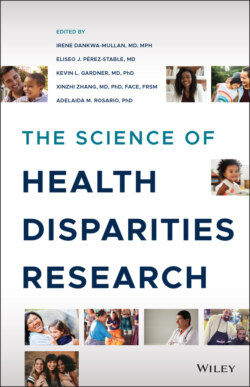Читать книгу The Science of Health Disparities Research - Группа авторов - Страница 55
3.4.1.3 Socioeconomic Status
ОглавлениеLower SES is consistently associated with poorer health outcomes. Adapted from Brown and colleagues [9], a conceptual framework of the distal mediators and moderators of the relationship between SES and health outcomes and behaviors is located in Figure 3.2. This model shows how socioeconomic factors influence multiple levels of distal and proximal mediators and moderators that impact health behaviors and outcomes. SES can be measured at the individual level, such as by annual household income, the highest level of educational attainment, and wealth (e.g., earnings, home ownership, and the net value of assets) by questionnaire. A full list of measures and references is located elsewhere [10].
Figure 3.2 Conceptual framework of the distal mediators and moderators of the relationship between socioeconomic status and health outcomes and behaviors.
Source: Based on Brown et al. [9].
Lower SES is known to affect health through psychosocial factors such as stress and depression, and health behaviors such as cigarette smoking and physical inactivity [11]. In recent literature, there has been a rise in the use of the term Socioeconomic Position (SEP), which is used instead of SES as both a “resource‐based and prestige‐based measure, as linked to both childhood and adult social class position” [12]. Resource measures are linked to income, wealth, and educational attainment, whereas prestige measures are linked to social hierarchy [12].
SES can also be measured at the community and neighborhood levels. Recent studies on SES include investigations of income inequality across cities or countries, as well as neighborhood poverty and access to resources in neighborhoods (see Other Social Determinants in Section 3.4.2 and examples of neighborhood environment in Section 3.5.3). Among developed nations, the United States has the highest income inequality, with the top 0.1% of the population owning nearly the same share of wealth as the bottom 90% [13]. The United States also has poorer health outcomes compared to other industrialized nations as measured by life expectancy, mental illness, obesity, infant mortality, teenage births, homicides, imprisonment, educational attainment, distrust, and social mobility.
The most commonly used measure of income inequality is the Gini coefficient, “formally defined as half of the arithmetic average of the absolute differences between all pairs of incomes within the sample, with the total then being normalized on mean income. If incomes are distributed completely equally, the value of the Gini will be zero. If one person has all the income, representing complete inequality, the Gini will assume a value of 1” [14].
Research on income inequality and health, including the role of violence, strongly supports a causal link [15]. Furthermore, a growing body of literature linking neighborhoods and health has shown that residing in a disadvantaged neighborhood is associated with increased rates of chronic disease [16]. Data suggest that these neighborhoods have fewer resources available to promote healthy behaviors and facilitate good health (further discussed in Section 3.4.2).
While this SES–health relationship has been robust across many health outcomes and at multiple levels, more work is needed to understand the complexity of the components of SES and how they affect health disparities [11]. These components do not always act independently but, instead, are affected by one another. Determining the biological mechanisms linking these social factors to disease outcomes has been a major priority for the field of social epidemiology.
Racial and ethnic minority populations, who have disproportionately lower SES, are especially affected by stressors related to their minority status (i.e., discrimination and racism) that exacerbate health disparities. Disentangling the effects of race and ethnicity from those of SES is extremely difficult due to the complex historical inequities and ongoing social issues. Rigorously designed studies to address this question are needed.
